Description
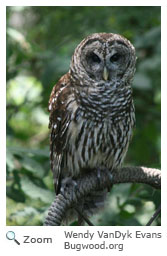 The Barred Owl is often identified by its recognizable call: "Who cooks for you? Who cooks for you-all?" It is a large, stocky owl with a round head and no ear tufts. The Barred Owl has brown and white feathers that make a vertical pattern on its front and a horizontal pattern on its throat. Females are larger than males. The Barred Owl is often identified by its recognizable call: "Who cooks for you? Who cooks for you-all?" It is a large, stocky owl with a round head and no ear tufts. The Barred Owl has brown and white feathers that make a vertical pattern on its front and a horizontal pattern on its throat. Females are larger than males.
Range
The Barred Owl has a large and growing range. It can be found from Western Canada into the Pacific Northwest and throughout the eastern half of the United States. It is present in both Texas and Florida. The Barred Owl does not migrate.
Habitat
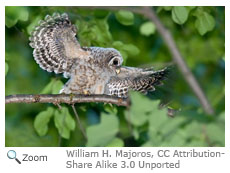 The Barred Owl is arboreal, meaning that it lives in trees. It prefers large, old-growth forests made of both deciduous and evergreen trees. The Barred Owl makes its nest in tree cavities, or holes in trees. As tree cavities are found most often in large, old trees, the Barred Owl is commonly found in old-growth forests. The Barred Owl is arboreal, meaning that it lives in trees. It prefers large, old-growth forests made of both deciduous and evergreen trees. The Barred Owl makes its nest in tree cavities, or holes in trees. As tree cavities are found most often in large, old trees, the Barred Owl is commonly found in old-growth forests.
|
|
Diet
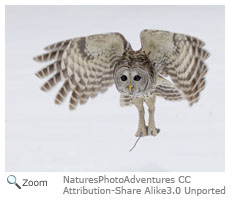 A carnivore, the Barred Owl eats small mammals, such as mice, squirrels and rabbits. It also preys on birds, reptiles, amphibians and insects. It only eats food that it can swallow whole. Hunting is done from a perch in a tree. The Barred Owl noiselessly swoops down and takes its prey in its sharp talons. Sometimes, the Barred owl will store food in its nest or a crook of a tree to eat later. A carnivore, the Barred Owl eats small mammals, such as mice, squirrels and rabbits. It also preys on birds, reptiles, amphibians and insects. It only eats food that it can swallow whole. Hunting is done from a perch in a tree. The Barred Owl noiselessly swoops down and takes its prey in its sharp talons. Sometimes, the Barred owl will store food in its nest or a crook of a tree to eat later.
Life Cycle
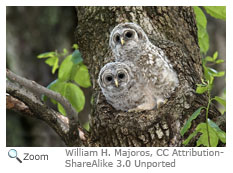 The Barred Owl breeds once a year, from December to March. The female lays two to three eggs and will incubate them for 28-33 days. While the female incubates her eggs, the male will hunt for food. Once the eggs hatch, chicks stay in the nest for three weeks and are fed by the male. When chicks are six weeks old, they learn to fly. Chicks stay with their parents for about six months before leaving the nest. The Barred Owl breeds once a year, from December to March. The female lays two to three eggs and will incubate them for 28-33 days. While the female incubates her eggs, the male will hunt for food. Once the eggs hatch, chicks stay in the nest for three weeks and are fed by the male. When chicks are six weeks old, they learn to fly. Chicks stay with their parents for about six months before leaving the nest.
Behavior
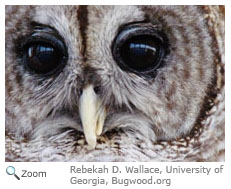 Original to the eastern United States, the Barred Owl has spread to the Pacific Northwest and into Northern California. It is competing for resources with a related species, the endangered Spotted Owl in the Pacific Northwest. Scientists are trying to decide how to protect the Spotted Owl since the arrival of the Barred Owl. Original to the eastern United States, the Barred Owl has spread to the Pacific Northwest and into Northern California. It is competing for resources with a related species, the endangered Spotted Owl in the Pacific Northwest. Scientists are trying to decide how to protect the Spotted Owl since the arrival of the Barred Owl. |





